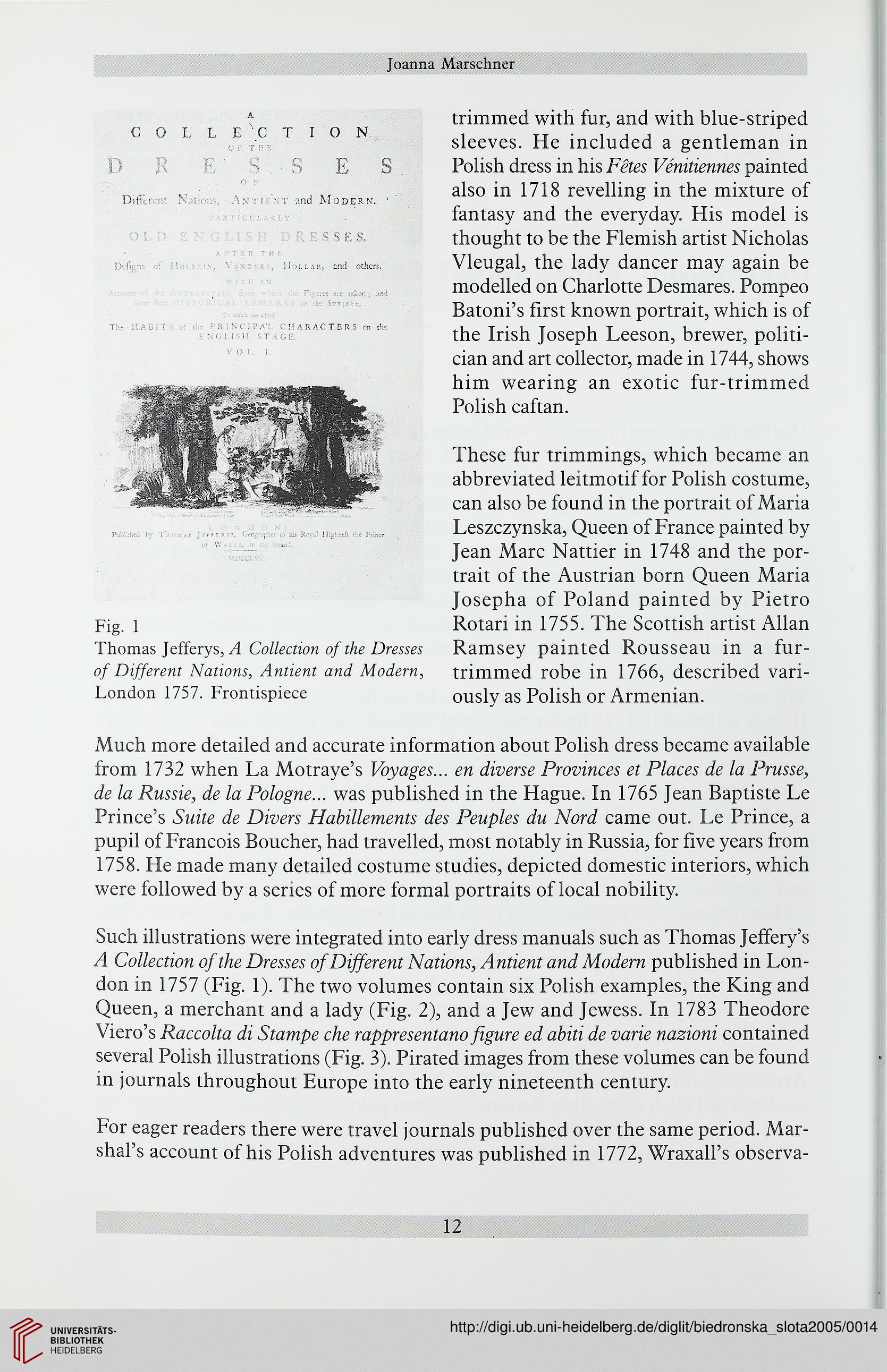Joanna Marschner
A
C O I. L E \C T I O N
d : * - 5 e s
o
Different Nations, A*?Tirsf and Mqdernt. '
S S E S,
,• r T E R T FJ r-
ptfiąna of HotssiNj Vakoys.i:, Hollar, and others.
The HABIT;; of ihe PR'1NC1PA'L CHARACTERS on the
[• N GLISH STA GE.
v o r. i
PuWiihtd by T u o m aj jfspftRr?, GwgrtpKr to h» Rcy»l H%
Fig. 1
Thomas Jefferys, y4 Collection of the Dresses
of Different Nations, Antient and Modern,
London 1757. Frontispiece
trimmed with fur, and with blue-striped
sleeves. He included a gentleman in
Polish dress in his Fetes Venitiennes painted
also in 1718 revelling in the mixture of
fantasy and the everyday. His model is
thought to be the Flemish artist Nicholas
Vleugal, the lady dancer may again be
modelled on Charlotte Desmares. Pompeo
Batoni's first known portrait, which is of
the Irish Joseph Leeson, brewer, politi-
cian and art collector, made in 1744, shows
him wearing an exotic fur-trimmed
Polish caftan.
These fur trimmings, which became an
abbreviated leitmotif for Polish costume,
can also be found in the portrait of Maria
Leszczyńska, Queen of France painted by
Jean Marc Nattier in 1748 and the por-
trait of the Austrian born Queen Maria
Josepha of Poland painted by Piętro
Rotari in 1755. The Scottish artist Allan
Ramsey painted Rousseau in a fur-
trimmed robe in 1766, described vari-
ously as Polish or Armenian.
Much more detailed and accurate information about Polish dress became available
from 1732 when La Motraye's Voyages... en diverse Provinces et Places de la Prusse,
de la Russie, de la Pologne... was published in the Hague. In 1765 Jean Baptiste Le
Prince's Suitę de Divers Habillements des Peuples du Nord came out. Le Prince, a
pupil of Francois Boucher, had travelled, most notably in Russia, for five years from
1758. He made many detailed costume studies, depicted domestic interiors, which
were followed by a series of more formal portraits of local nobility.
Such illustrations were integrated into early dress manuals such as Thomas Jeffery's
A Collection of the Dresses of Different Nations, Antient and Modern published in Lon-
don in 1757 (Fig. 1). The two volumes contain six Polish examples, the King and
Queen, a merchant and a lady (Fig. 2), and a Jew and Jewess. In 1783 Theodore
Viero's Raccolta di Stampe che rappresentano figurę ed abiti de varie nazioni contained
several Polish illustrations (Fig. 3). Pirated images from these volumes can be found
in journals throughout Europę into the early nineteenth century.
For eager readers there were travel journals published over the same period. Mar-
shall account of his Polish adventures was published in 1772, Wraxall's observa-
12
A
C O I. L E \C T I O N
d : * - 5 e s
o
Different Nations, A*?Tirsf and Mqdernt. '
S S E S,
,• r T E R T FJ r-
ptfiąna of HotssiNj Vakoys.i:, Hollar, and others.
The HABIT;; of ihe PR'1NC1PA'L CHARACTERS on the
[• N GLISH STA GE.
v o r. i
PuWiihtd by T u o m aj jfspftRr?, GwgrtpKr to h» Rcy»l H%
Fig. 1
Thomas Jefferys, y4 Collection of the Dresses
of Different Nations, Antient and Modern,
London 1757. Frontispiece
trimmed with fur, and with blue-striped
sleeves. He included a gentleman in
Polish dress in his Fetes Venitiennes painted
also in 1718 revelling in the mixture of
fantasy and the everyday. His model is
thought to be the Flemish artist Nicholas
Vleugal, the lady dancer may again be
modelled on Charlotte Desmares. Pompeo
Batoni's first known portrait, which is of
the Irish Joseph Leeson, brewer, politi-
cian and art collector, made in 1744, shows
him wearing an exotic fur-trimmed
Polish caftan.
These fur trimmings, which became an
abbreviated leitmotif for Polish costume,
can also be found in the portrait of Maria
Leszczyńska, Queen of France painted by
Jean Marc Nattier in 1748 and the por-
trait of the Austrian born Queen Maria
Josepha of Poland painted by Piętro
Rotari in 1755. The Scottish artist Allan
Ramsey painted Rousseau in a fur-
trimmed robe in 1766, described vari-
ously as Polish or Armenian.
Much more detailed and accurate information about Polish dress became available
from 1732 when La Motraye's Voyages... en diverse Provinces et Places de la Prusse,
de la Russie, de la Pologne... was published in the Hague. In 1765 Jean Baptiste Le
Prince's Suitę de Divers Habillements des Peuples du Nord came out. Le Prince, a
pupil of Francois Boucher, had travelled, most notably in Russia, for five years from
1758. He made many detailed costume studies, depicted domestic interiors, which
were followed by a series of more formal portraits of local nobility.
Such illustrations were integrated into early dress manuals such as Thomas Jeffery's
A Collection of the Dresses of Different Nations, Antient and Modern published in Lon-
don in 1757 (Fig. 1). The two volumes contain six Polish examples, the King and
Queen, a merchant and a lady (Fig. 2), and a Jew and Jewess. In 1783 Theodore
Viero's Raccolta di Stampe che rappresentano figurę ed abiti de varie nazioni contained
several Polish illustrations (Fig. 3). Pirated images from these volumes can be found
in journals throughout Europę into the early nineteenth century.
For eager readers there were travel journals published over the same period. Mar-
shall account of his Polish adventures was published in 1772, Wraxall's observa-
12





